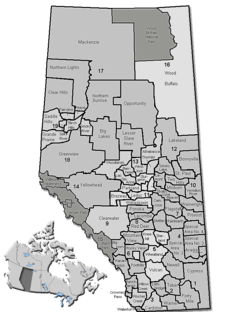Saddle Hills County
| Saddle Hills County | |
|---|---|
| Municipal district | |
| Motto: In the heart of Alberta's oil and gas country | |
 Location of Saddle Hills County in Alberta | |
| Coordinates: 55°46′55″N 118°50′2″W / 55.78194°N 118.83389°WCoordinates: 55°46′55″N 118°50′2″W / 55.78194°N 118.83389°W | |
| Country |
|
| Province |
|
| Region | Northern Alberta |
| Census division | No. 19 |
| Established | 1945 |
| Incorporated | 1995 (Municipal district) |
| 1999 (County) | |
| Government[1] | |
| • Reeve | Alvin Hubert |
| • Governing body | Saddle Hills County Council |
| • Office location | west of Spirit River |
| Area (2011)[2] | |
| • Total | 5,836.92 km2 (2,253.65 sq mi) |
| Population (2011)[2] | |
| • Total | 2,288 |
| • Density | 0.4/km2 (1/sq mi) |
| • Dwellings | 977 |
| Time zone | MST (UTC-7) |
| Website |
saddlehills |
Saddle Hills County is a municipal district situated in the central portion of the Peace Country in northwest Alberta, Canada. Located approximately 450 km (280 mi) northwest of Edmonton and 90 km (56 mi) north of Grande Prairie, its municipal office is located approximately 25 km (16 mi) west of the Town of Spirit River at the intersection of Highway 49 and Highway 725.
Demographics
In the 2011 Census, Saddle Hills County had a population of 2,288 living in 878 of its 973 total dwellings, a -6.9% change from its 2006 population of 2,458. With a land area of 5,836.92 km2 (2,253.65 sq mi), it had a population density of 0.4/km2 (1.0/sq mi) in 2011.[2]
The population of Saddle Hills County according to its 2008 municipal census is 2,478.[3]
In 2006, Saddle Hills County had a population of 2,458 living in 977 dwellings, a 4.2% decrease from 2001. The municipal district has a land area of 5,836.94 km2 (2,253.66 sq mi) and a population density of 0.4/km2 (1.0/sq mi).[4]
In 2001, Saddle Hills County had a population of 2,566 in 1,025 dwellings, a 5.8% decrease from 1996. On a surface of 5,836.42 km² it had a density of 0.4 inhabitants/km².[5]
Economy
Saddle Hills County has a diverse agricultural community and deposits of natural gas and oil.
Government
County Council is responsible for providing overall governance for our community including establishing municipal service levels, approving the annual budget and local taxation levels. Council has seven members and is headed by a reeve. The reeve, currently Alvin Hubert, is the chief elected officer and is elected from within council. It is the reeve's responsibility to chair all council meetings and speak on behalf of council and the community.
Council provides direction to its administration through its chief administrative officer (CAO). The CAO is responsible for the overall administration of the county and for advising and making recommendations to county council on matters concerning the municipality.
Communities and localities
|
The following urban municipalities are surrounded by Saddle Hills County:[6]
The following hamlets are located within Saddle Hills County:[6] |
The following localities are located within Saddle Hills County:[7]
|
See also
References
- ↑ "Municipal Officials Search". Alberta Municipal Affairs. December 16, 2016. Retrieved December 18, 2016.
- 1 2 3 "Population and dwelling counts, for Canada, provinces and territories, and census subdivisions (municipalities), 2011 and 2006 censuses (Alberta)". Statistics Canada. 2012-02-08. Retrieved 2012-02-08.
- ↑ Alberta Municipal Affairs (2009-09-15). "Alberta 2009 Official Population List" (PDF). Retrieved 2010-09-12.
- ↑ Statistics Canada. "Canada 2006 Census: Saddle Hills County - Community Profile". Retrieved 2007-06-11.
- ↑ Saddle Hills County community profile - Statistics Canada. 2002. 2001 Community Profiles. Released June 27, 2002. Last modified: 2005-11-30. Statistics Canada Catalogue no. 93F0053XIE
- 1 2 "Specialized and Rural Municipalities and Their Communities" (PDF). Alberta Municipal Affairs. 2012-03-01. Retrieved 2012-08-12.
- ↑ "Standard Geographical Classification (SGC) 2006, Economic Regions: 4819059 - Saddle Hills County, geographical codes and localities, 2006". Statistics Canada. 2010-03-05. Retrieved 2012-08-12.
